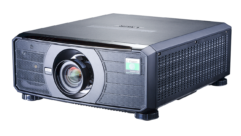PROJECTION SYSTEMS IN HOUSES OF WORSHIP
Jan 1, 2001 12:00 PM,
Chris O’Neal
Soaring ceilings… prominent arches… detailedengraving on every surface.… Classical houses of worship usedarchitecture to enhance and amplify sound and to please the eyes ofworshippers. They were constructed to allow as many people aspossible to see the holy rituals carried out on the platform.Nowadays, almost every church has a sound system, stage lighting,phone systems with voice mail, a Web site, personal computers,alarm systems and—yes—video projection systems. Theseare technologies we have become accustomed to in our secular lives,and they are providing welcome enhancements to our houses ofworship as well. Congregations want video projection systemsbecause many have found that it is a great tool for reaching peoplewho don’t attend church regularly.
There may have been some backlash when churches first began toinstall electronic systems, but now they are accepted as standard.Today, the biggest problem for churches installing systems is thelack of technical education. Churches are also on a limited budgetand can’t afford to make the wrong decision when purchasing videoprojection equipment. Their challenge is getting the rightprojection solution that creates the right atmosphere andcomplements the worship service. As a contractor, you can buildtrust and make it easy for church committees with good planning,good design and careful budgeting.
SOUNDS LIKE A PLAN
Getting the right solution starts with a vision. Churchofficials should feel that their church would be served well by anew system, and their conscience should guide their decisions.Planning for large-screen projection begins with knowing thecongregation. Most churches don’t accept change very well becausethere are so many differing opinions on how the devout shouldworship. The spiritual leader may not be technically inclined, buthe or she is the best person to decide what will be accepted by thecongregation. A team made up of one or two prayer leaders and abunch of “techies” works well for coming up with thebest solutions for the church. However, this cannot take the placeof professional opinions and demonstrations from local dealers.Dealers have experience from installations and can be veryhelpful.
The importance of planning for large-screen projection is ascritical as planning for audio or lighting systems because of theequipment and installation costs. A properly installed and operatedaudio system is essential but can take away from the divine messagequickly if there are problems. Like buying a low-cost wirelessmicrophone that drops out just as a preacher reaches the high pointof the sermon, spending the least possible amount of money on aninadequate projection system can cause distractions. Look for asolution that fits the needs of the congregation and is easy tooperate. Most technical teams at houses of worship are volunteerswho don’t work with video projection equipment every day—sothe equipment needs to be easy to understand. Using two screens maybe necessary in a wide worship center, while one wide screen willwork fine in a long, narrow one. Proper placement of a screen canincrease the system’s effectiveness by letting the congregation seethe pastor’s facial expressions during the sermon, see lyrics tosongs in large print, see notes that follow a rabbi’s sermon, andwatch videos that stir the emotions of the heart. In someinstances, screens that are placed too far to the sides of the mainplatform can distract the worship leader because everyone islooking at the screens instead of the platform. Screens that aretoo small can be difficult to view and more of a distraction thanan enhancement to the service. Ask what the church is looking for,listen to their desires and try your best to meet their requests.Take time to think through all the options.
The planning stage will probably take from one to three months,but the purchase could take as long as a year. Be patient. Keep intouch with the church contact so the church knows you care abouttheir needs for a projection system. You become their expert in thefield, and they should be able to trust you and talk to you whenthey need help.
DESIGN PHASE
If church leaders are able to increase their knowledge ofprojection systems, they will feel more comfortable in the finaldecision and understand what is being designed for them. Most largemanufacturers publish guides for using their products. Be familiarwith them and make them available to the church. This makes you aresource for information and a valuable player in their project.Subscribe to electronic newsletters and magazines so you can readabout other church installations and new products. Keeping in touchwith the industry and having a good understanding of large screenprojection use in worship centers can make the difference betweencreating the right projection solution and using a“cookie-cutter” design for every church. I rememberfour or five years ago when churches were being told that 1,000ANSI Lumens was plenty of brightness. A good design should be basedon the size of the room, lighting conditions and system usage— unique in every case.
A good design starts with the correct size screen. A screenshould be sized to comfortably serve the majority of the audience.Depending on the use of the screen, this can be determined bydividing the distance from the screen to the farthest row of seatsby as little as eight and as much as ten. Manufacturer’s meet mostof the quality criteria for churches but you’ll always get what youpay for. Using a larger screen to make lyrics easy to read foreveryone will mean a brighter projector will be needed. Match thesize of the screen to the congregation’s need and then size theprojector to the screen.
It seems that projector features are changing every day, but,like computers, you have to buy what you need at the time you needit. Churches can’t always afford the best, but they need to realizethat lower priced models usually create a lower quality image. XGA(1024 × 768) resolution is the lowest resolution that a churchshould consider. The higher the resolution, the higher the price.Projector brightness is determined by the amount of screen surfaceand the screen material being used in conjunction with the amountof light where the screen will be located. SMPTE (Society of MotionPicture and Television Engineers) recommends 18 to 20 foot-candlesof brightness to have a well-projected image. The amount of lighton the screen needs to be added to this to determine the neededprojector brightness.
Cabling, video sources, converters and D/As (distributionamplifiers) are as important as the quality of the projector andscreen. If you start with a high-quality video source and use alow-quality cable or D/A, the video signal can degrade and give aless than desirable projected image. Cables and peripheralsshouldn’t be left out of the discussion either. Some new devicescan convert video and control signals to a digital signal, send itup to 300 feet, and then convert it back to an analog signal. Thesedevices can simplify installation, reduce labor and giveflexibility to the customer. Like everything else, price determinesquality. Low-priced devices and cables can lose resolution, clarityand bandwidth.
BUDGETING
Budgets are important but shouldn’t keep a house of worship frominstalling the right equipment. Sometimes a church will pick anamount that they want to spend rather than create a budget for whatthey need. Design for all of the equipment you need then offeroptions for everything they might need or want so the system willperform to its fullest capabilities. Churches don’t always knoweverything that is available to them. Help them decide whether theyneed to finance this amount, lease the equipment or raise the moneyin advance of the purchase. Some leasing plans allow for upgradingequipment so they won’t have to worry about outgrowing theirprojection needs. Installing a projection system in stages might bemore affordable but can often cause problems in justifying futurepurchases and sacrifice quality for lower immediate costs.
Chris O’Neal is co-owner and operations manager of ParagonMultimedia Imaging and Paragon Video Productions, an Atlanta areaChristian video company that serves churches and Christianorganizations through multimedia. Chris teaches multimedia seminarsfor churches, architects and corporations. He serves as thetechnical director at Kennesaw First Baptist Church in the Atlantaarea, where he and his family attend. Write to: [email protected] or visit www.projectionsolutions.com for moreinformation on Projection Solutions.










